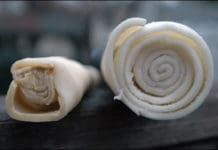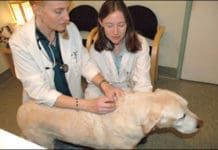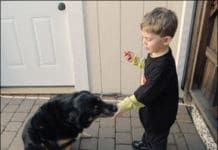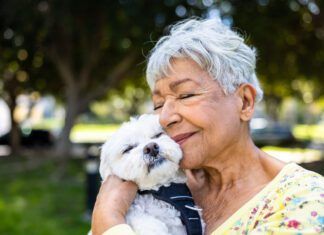Dogs Riding Safely and Calmly in Cars
Contrary to the advice I offer to clients and WDJ readers, I admit that I'm sometimes careless about taking my dogs in the car with me. I don't always use crates and seatbelts on short trips to town, although I always do on longer travels. Just recently, however, my husband and I loaded up all five of our dogs for their annual well-pet visit to a veterinarian, and I did take the precaution of crating everyone rather than risk canine chaos on the highway. Other than Bonnie's panting, it was an experience in car-ride serenity, and I vowed to crate everyone, always, on future rides. Granted, my dogs aren't the worst in the car. They don't sit in my lap, leap over seats, get into fights, hang out the windows, do laps around the back of the van, or bark at everything outside the car. Other than Bonnie, who pants a lot and sometimes Even so, they're safer in crates. Loose, they are a distraction, which decreases my driving safety. Not as bad as texting, but still!
Introducing Your Dog to New Activities
Three months ago, I introduced Otto to canoeing. This was only a couple of weeks after my husband had unwittingly traumatized Otto by dragging him across some fast-moving streams on a fishing trip. When I briefly described that event in the August issue, I don’t think I mentioned that this fishing trip happened when I was out of town; I didn’t learn that Brian was going to take Otto fishing until after it was all over. Brian tends to fish for many hours in a focused way; had I known about the trip, I would have tried to convince him that bringing the dog would be a distraction, and that Otto would need support and attention on a new type of adventure. Otto has, on a number of occasions, shown himself to be a little anxious about new experiences. So I’ve tried very hard to introduce him to strange places or activities in stages, always leaving plenty of time to allow him to explore and learn to deal with novel situations at his own pace. And I don’t take him anywhere new without a lot of high-value treats on hand, so I can reinforce any effort on his part to be brave – and to classically condition him to enjoy trying new things. In the long run, I want Otto to be able to confidently and happily go camping, backpacking, hiking, fishing, and, yes, canoeing with us.
Acupuncture For Dogs With Cancer
without any hesitation
Blossoming Dogs
and unsure about people. Attending K9 Nose Work classes has helped her personality blossom! It is a sport in which any dog can participate
Training Your Dog to Comfortably Wear a Muzzle
Long thought to be a sign of a bad dog
Selecting The Best Family Dog and Preparing Him for Children
not just tolerate them. And if she shows signs of discomfort (such as looking away or moving away from children)
Finding the Right Rawhide Chew For Your Dog
but they are anything but equal in terms of safety
Pet Insurance
Last year my Border Terrier, Dash, received advanced canine dental treatments to the tune of more than $2,500 (described in "Improve Your Dental Acuity," Whole Dog Journal July 2008). Her root canal, surgical extraction, and periodontal treatments were necessary to improve her health, but they certainly stretched my checkbook until I could hear the twang! Fortunately, I was able to afford these procedures. But, who knows what could happen next to either of my two dogs, and how much it might cost? And how can I be prepared to provide a lifetime of high quality healthcare when my next puppy comes along? For the first time I am seriously considering the benefits of pet health insurance for my dogs (both seniors), and, especially, for any young dog who joins my family in the future.Advances in veterinary science have led to the availability of high-tech wellness care, diagnostic testing, treatments, and surgical procedures. Cancer care, MRIs, pacemakers, joint replacements, and, yes, advanced dental care are increasingly common. Many private veterinary practices now offer high-tech procedures previously offered only at regional, specialty referral clinics. The American Pet Products Association (APPA) estimates that, in 2008, dog owners spent more than $10 billion on veterinary care. The APPA's 2007/2008 national pet survey reported that the average "routine veterinary visit" for a dog cost more than $200, and the average "surgical vet visit" cost more than $450. Advanced, high-tech treatments cost much more. If you want to provide your dog with high quality healthcare throughout his life, pet health insurance deserves a serious look. And since you can't buy health insurance for your dog when you really need it most, like in an emergency, or when a pre-existing condition erupts into a critical situation, now is the best time to look into health insurance that could save you hundreds or even thousands of dollars.
Canine Acupressure Techniques to Promote Healing
located in a depression just in front of the greater trochanter (large bony protuberance) of the femur; BL 54
Train Your Dog to Behave During Grooming
Two months ago, I read a news story about a dog owner in Minnesota who had shared her home and her life with her 10-year-old Great Pyrenees for eight years. On December 30, 2008, the dog attacked his owner as she was trying to trim his nails, sending her to the hospital for multiple bite wounds to her arms. The news report on the incident stated, “[The dog owner] was able to reach another room and closed the door, keeping the dog out.” The owner in this sad story was treated and released from the hospital the same day. The dog is now dead – euthanized at the veterinary hospital for safety reasons, at the owner’s request.Nail-trimming should not be a matter of life and death. Nor should any other routine grooming procedure. If a dog objects strongly to any sort of physical contact or restraint that may occur in the process of ordinary care, a smart, responsible owner needs to take immediate steps to overcome his objections in a positive, nonaversive manner. Fortunately, this process (described in detail below) is not difficult (or dangerous!) to do – but it does take a serious commitment of time.
Challenging Topics
I have been meaning to write this e-mail for some time. Whole Dog Journal has done such a tremendous job of providing high-quality, informative articles this year. In particular, I was most impressed with the article about dental care and the vaccine article featuring Dr. Ron Schultz. Your writers did such a top-notch job of researching complex topics and providing fair and accurate information and opinions. As a veterinarian myself, I sometimes read such articles with an overly critical eye, but I could find nothing at fault with either of these. In fact, I was so ecstatic with the dental care article that I had my entire staff read it, so they could see from a dog-owner’s perspective why high quality dental care is so important.
Your Children Should Help Train the Dog
Unless you've been living in a cave for the past year, you know that Malia and Sasha Obama will soon be getting their very first dog. Every year, children all over the world experience the joy of holding a dog or puppy in their arms for the very first time. We trust that the Obamas will select wisely, and make the right training choices for the newest member of the First Family. If a new dog is in your future, we hope that you'll do the same.For many kids, getting a family dog is one of the happiest experiences imaginable. However, disturbing dog bite statistics from the Centers for Disease Control (CDC) suggest that all is not well in the kid-dog kingdom. According to the CDC, each year, 800,000 Americans seek medical attention for dog bites. Half of these are children. Your best insurance against your family being part of these statistics is a puppy-raising program that incorporates proper management and supervision and tons of carefully orchestrated, positive social experiences for your new dog. (For more about how to carry out an ideal socialization program, see The Social Scene


















